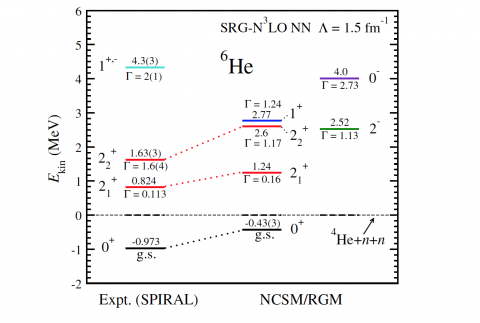
The basic interaction between the constituents of an atomic nucleus ('nucleons' means neutrons or protons) has been well understood for decades; however, the interaction’s strength has meant that calculations for all but the very simplest nuclear systems (e.g. the deuteron = 1 proton + 1 neutron) were initially too complex to do from basic principles, necessitating various approximation methods to make reliable predictions. Nonetheless, theoretical groups worldwide have persevered in their attempts at establishing reliable “ab initio” techniques, and much progress has been made in describing ever-larger nuclei starting from the fundamental nucleon forces. TRIUMF theorists have been at the forefront of many of these advances.
Recently, scientists from TRIUMF and the Lawrence Livermore National Laboratory (LLNL) published a paper in the prestigious Physical Review Letters outlining a technique which for the first time enables researchers to analyze systems of three nuclear clusters in relative motion while treating the individual nucleons as fundamental components interacting by accurate nucleon-nucleon interactions. The work by the Theory postdoc Carolina Romero-Redondo and Petr Navratil (Theory Department, TRIUMF) in conjunction with Sofia Quaglioni and Guillaume Hupin (LLNL) has produced the first successful ab initio analysis describing energy states in the He-6 nucleus (2 protons + 4 neutrons).
He-6 is an exotic nucleus that can be described as a three-cluster “halo” nucleus - a tightly bound He-4 core orbited by two neutrons. Part of what makes this particular nucleus so fascinating is that though the trio are bound together when all three bodies are present, removing just one renders the whole structure unstable. These are known as “Borromean” nuclei, after the similarly named Borromean rings, which exhibit a similar all-or-nothing structure. The He-6 nucleus is difficult to study experimentally and as such its energy spectrum is not yet firmly established. Excitingly, the results by Romero-Redondo, et al. are consistent with recent experiments, correctly identifying some known energy states ('resonances'). They also predict new energy states and do not find others (e.g. low-energy “1-“ state) predicted by other formalisms.
In the future, this new approach will be applied to study systems such as H-5 as a 3H+n+n trio, and Li-11 as a 9Li+n+n configuration.
Having completed her term at TRIUMF, Carolina will continue her innovative research on three-cluster systems at her new appointment at LLNL.
Congratulations to Romero-Redondo and her colleagues for this excellent contribution!
–Nick Leach, Outreach Assistant
For the full article, please refer to Physical Review Letters 113, 032503 (2014).
Figure: The energy spectrum of He-6. The measured states are on the left, and correspond to the latest experiment performed at SPIRAL (GANIL) lab, while the calculated states are on the right.
